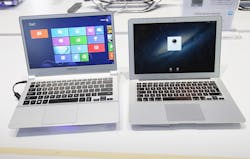Robotic Arm for Child Designed with 3-D Printer
University of Central Florida (UCF) Engineering Students have developed a robotic arm for 6-year-old Alex Pring, using a Stratasys 3D Printer.
Aerospace engineering Ph.D. student and Fulbright Scholar Albert Manero is a volunteer at E-Nable, a network of 3-D printing enthusiast’s whose goal is to develop 3-D prosthetic hands for those in need. Manero met Alex, who was born without his right arm, through the E-Nable online network. The UCF engineering students designed and 3-D printed a functional prosthetic arm for Alex.
Manero, along with his team, dedicated seven weeks for their design. The Dimension Elite 3D Printer delivered rapid design iteration during the process and the Ivory ABS material used was strong, yet light enough for Alex to easily move.
“He learned to use the prosthetic fast,” Manero said. “When he could control it, the first thing he did was hug his mother. He said it was their first real hug. There wasn’t a dry eye in the room. I think 3-D printing is revolutionizing our world in many ways. I believe changing the world of prosthetics is very real,” adds Manero.
The UCF team will continue to look for new ways to improve their design. As Pring gets older, the team will be able to 3D print a larger arm for a fraction of the cost of traditional prosthetics. “I can shake two people’s hands at once,” Pring joked. The team plans to publish the design files online for public access with instructions to 3-D print it so more lives can be transformed.
“3-D printing is changing the way prosthetics are designed and produced in ways previously not possible,” notes Gilad Gans, president, Stratasys North America. “It’s a remarkable feeling when you see how 3-D printing gives a kid the chance to live a happy life like other kids.”
About the Author

Adrienne Selko
Senior Editor - MH&L, IW, & EHS Today
Adrienne Selko has written about many topics over the 17 years she has been with Endeavor Business Media and currently focuses on workforce development strategies. Previously Adrienne was in corporate communications at a medical manufacturing company as well as a large regional bank.
She is the author of Do I Have to Wear Garlic Around My Neck? which made the Cleveland Plain Dealer's best sellers list. She is a senior editor at Material Handling & Logistics, EHS Today, and IndustryWeek.
Editorial Mission Statement:
Manufacturing is the enviable position of creating products, processes, and policies that solve the world’s problems. When the industry stepped up to manufacture what was necessary to combat the pandemic, it revealed its true nature. My goal is to showcase the sector’s ability to address a broad range of workforce issues including technology, training, diversity & inclusion, with a goal of enticing future generations to join this amazing sector.
Why I Find Manufacturing Interesting:
On my first day working for a company that made medical equipment such as MRIs, I toured the plant floor. On every wall was a photo of a person, mostly children. I asked my supervisor why this was the case and he said that the work we do at this company has saved these people’s lives. “We never forget how important our work is and everyone’s contribution to that.” From that moment on I was hooked on manufacturing.
I have talked with many people in this field who have transformed their own career development to assist others. For example, companies are hiring those with disabilities, those previously incarcerated, and other talent pools that have been underutilized. I have talked with leaders who have brought out the best in their workforce, as well as employees doing their best work while doing good for the world.
